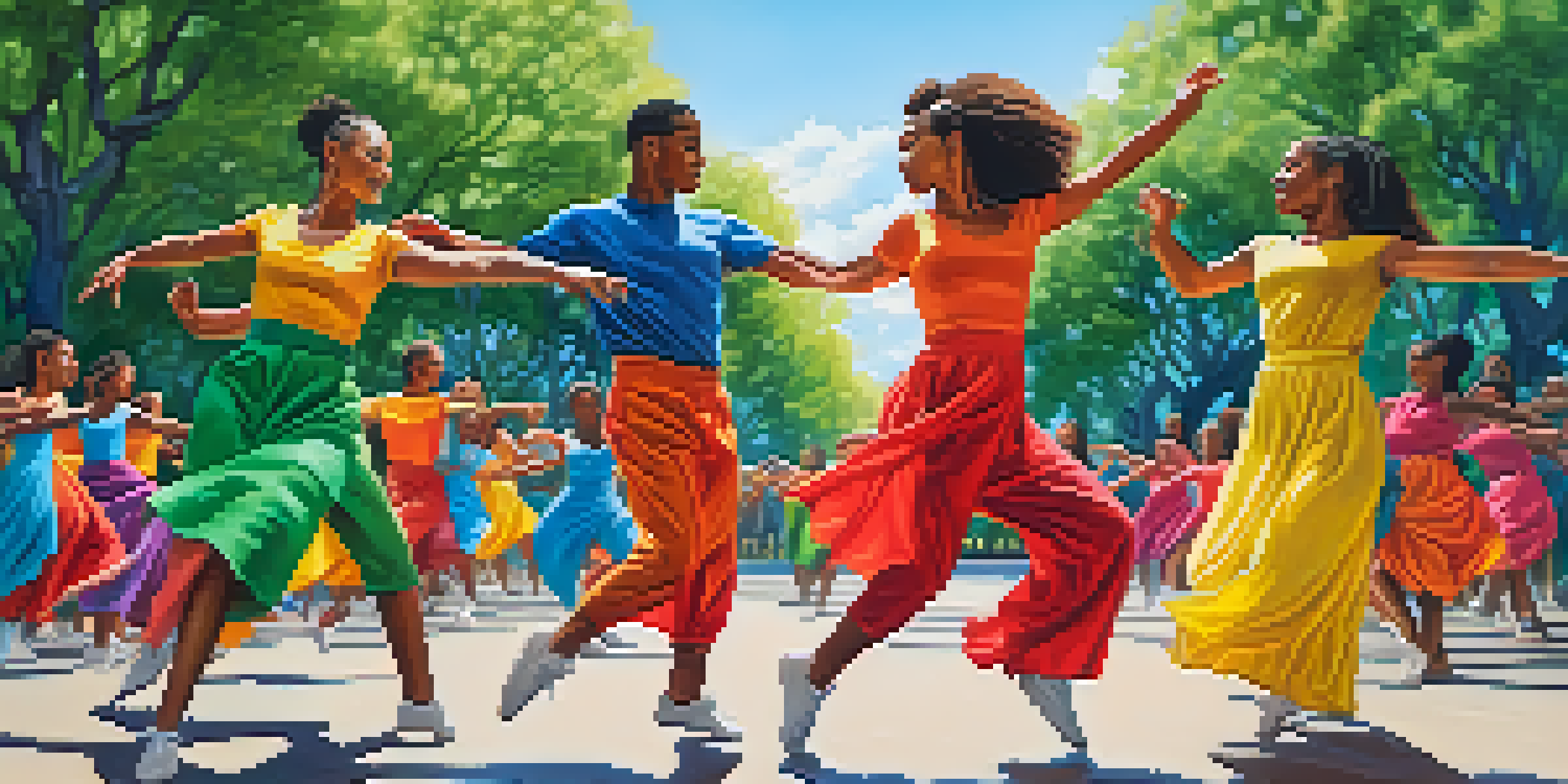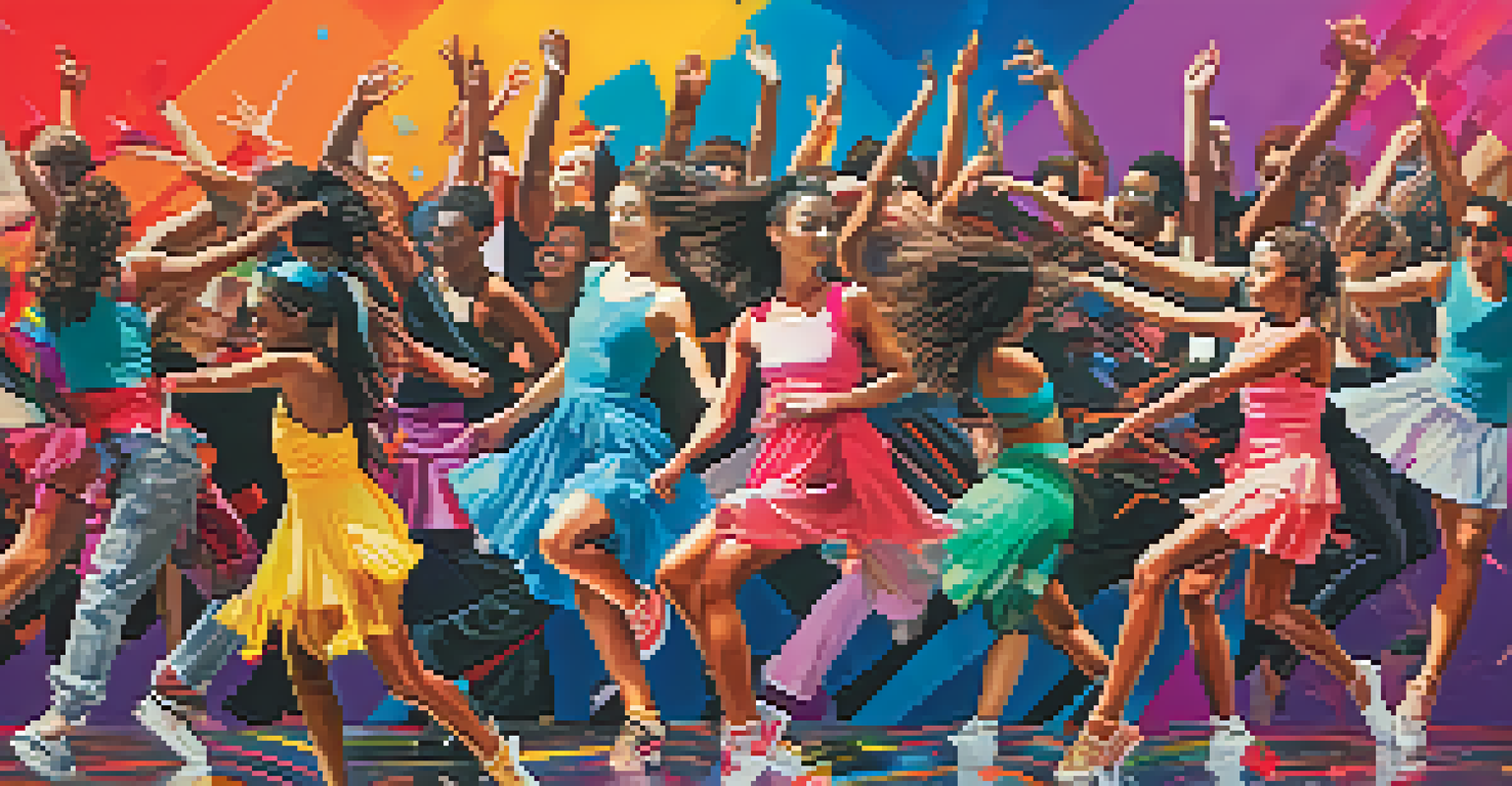Dance as Protest: Choreography of Social Movements

The Historical Roots of Dance as Protest
Throughout history, dance has often been a powerful medium for expressing dissent. From the civil rights movements to anti-war protests, choreographed movements have conveyed messages of resistance and hope. For instance, the 1960s saw activists using dance to unite people and amplify their calls for justice.
Dance is the hidden language of the soul.
These historical examples illustrate how dance transcends language barriers, making it accessible to a diverse audience. The rhythms and movements can evoke deep emotions that resonate with collective struggles, encouraging participation and solidarity. It's fascinating to see how a simple gesture can spark widespread action.
Moreover, this form of protest often invites creativity and innovation, allowing participants to express their unique perspectives. As people come together to dance, they forge connections not only with each other but also with the larger social movements they represent. In this way, dance becomes a living archive of activism and resilience.
Notable Examples of Dance as Protest
One of the most iconic examples of dance as protest is the 'Dancing for Freedom' movement, where groups gathered to dance in public spaces to advocate for human rights. This lively form of expression drew attention to serious issues while creating a sense of community among participants. The joy of dance contrasted with the gravity of their message, making it an unforgettable experience for both dancers and onlookers.

Another powerful instance is the 'Break the Silence' flash mob, which used street dance to highlight domestic violence. This unexpected performance in a public space turned heads and sparked conversations, proving that art can be a catalyst for change. The energetic choreography not only raised awareness but also provided a platform for survivors to share their stories.
Dance as a Voice for Change
Throughout history, dance has served as a powerful medium for expressing dissent and uniting communities in social movements.
These examples show that dance can disrupt the status quo and challenge societal norms. By transforming public spaces into stages, activists harness the power of movement to engage audiences in dialogue and reflection. The act of dancing invites empathy, bridging gaps between communities and inspiring collective action.
Choreography as a Form of Storytelling
Choreography is more than just movement; it's a powerful storytelling tool that conveys emotions and narratives. When dancers perform, they share stories of struggle, resilience, and hope, allowing audiences to connect on a deeper level. This connection can lead to greater awareness and understanding of the social issues at hand.
Art enables us to find ourselves and lose ourselves at the same time.
Take, for example, the work of choreographer Bill T. Jones, who often incorporates themes of social justice in his performances. His pieces challenge viewers to confront uncomfortable truths while also celebrating the human spirit. Through dance, he weaves personal and collective narratives that encourage reflection and dialogue.
By using choreography to tell stories, dancers can evoke empathy and inspire change. This art form invites audiences into the heart of the issues, fostering a sense of urgency and motivating action. In this way, dance becomes an essential part of the conversation around social movements.
The Role of Community in Dance Protests
Community plays a vital role in the effectiveness of dance as protest. When individuals come together to dance, they create a sense of belonging and shared purpose. This collective energy can amplify their message, making it more impactful and memorable.
Groups like the Black Lives Matter movement have embraced dance as a way to unite people and express their solidarity. Through organized dance events, participants not only honor the lives lost to violence but also celebrate their culture and resilience. This communal aspect transforms individual acts of protest into powerful statements of unity.
Community Strengthens Protest
The collective energy of community-driven dance events amplifies messages of solidarity and fosters inclusivity.
Additionally, community-driven dance events foster inclusivity and encourage diverse voices to be heard. By providing a platform for different perspectives, these gatherings can spark important conversations and inspire action across various demographics. Ultimately, the strength of dance as protest lies in its ability to bring people together for a common cause.
Dance in Digital Activism
In today's digital age, dance has found new life as a form of online activism. Social media platforms have enabled dancers to share their messages with a global audience, often leading to viral movements. This digital landscape allows for creativity and collaboration across borders, making dance a universal language of protest.
For instance, the 'Dance Challenge for Change' campaign encouraged participants to create and share videos that address social issues. These short, engaging performances not only spread awareness but also motivated viewers to take action in their own communities. The power of social media amplifies the reach and impact of these dance protests, allowing them to resonate with even more people.
Furthermore, online dance activism fosters a sense of community among participants who may never meet in person. This virtual connection reinforces the idea that art can unite people regardless of geographical barriers. Dance, in this sense, becomes a global movement for change, transcending cultural and linguistic differences.
The Emotional Impact of Dance Protests
One of the most profound aspects of dance as protest is its emotional impact on both participants and audiences. Dance can evoke powerful feelings, turning raw emotions into movement that resonates deeply. This ability to connect on an emotional level is what makes dance a compelling form of protest.
For example, the 'Silent Dance' movement invited participants to dance without music in public spaces, creating a haunting yet beautiful atmosphere. This silence contrasted with the loudness of their message, allowing viewers to reflect on the issues at hand. The emotional weight of such performances can leave a lasting impression, prompting individuals to consider their roles in social change.
Digital Dance Activism Rising
In the digital age, social media has transformed dance into a global language of protest, enabling widespread awareness and engagement.
Moreover, the cathartic nature of dance can empower participants, helping them process their experiences and emotions. This transformative aspect can be particularly important for marginalized communities, as dance provides a safe space for expression. By channeling their feelings into movement, dancers not only advocate for change but also heal themselves and their communities.
Future Directions: Dance and Social Change
As we look to the future, the intersection of dance and social movements continues to evolve. New generations of artists are exploring innovative ways to use dance as a tool for activism, pushing boundaries and challenging conventions. The ongoing dialogue between dance and social issues ensures that this art form remains relevant and impactful.
Emerging technologies, such as virtual reality and augmented reality, are also opening up exciting possibilities for dance activism. These tools can create immersive experiences that draw audiences into the heart of social issues, making the message even more powerful. The fusion of technology and dance could revolutionize how we engage with activism.

Ultimately, the future of dance as protest lies in its ability to adapt and resonate with contemporary audiences. As long as there are voices calling for change, dance will remain a vital means of expression and a source of inspiration. The choreography of social movements will continue to evolve, motivating individuals to join the dance for justice.